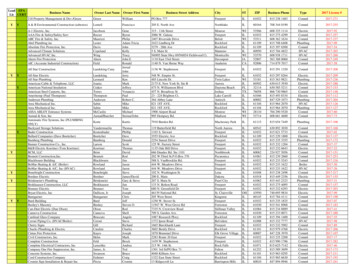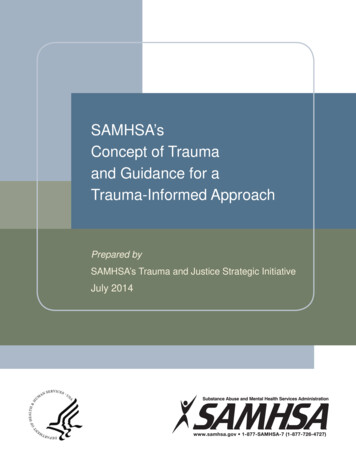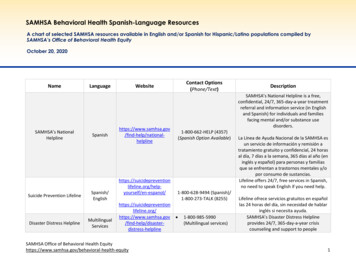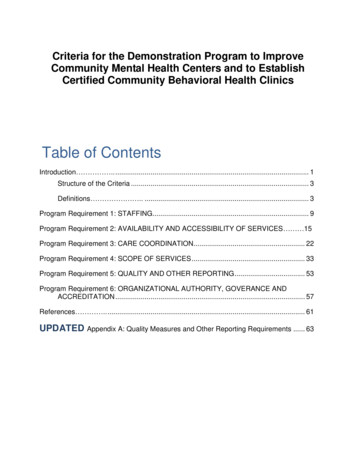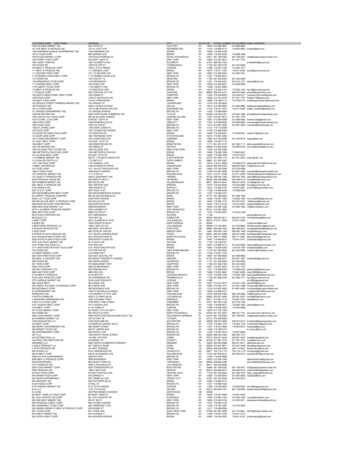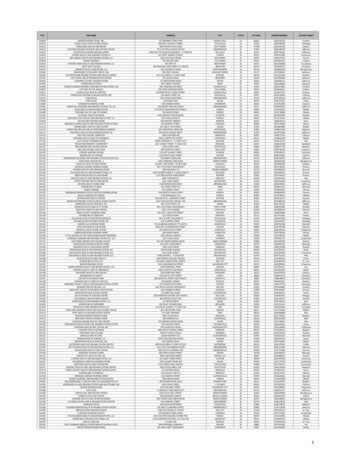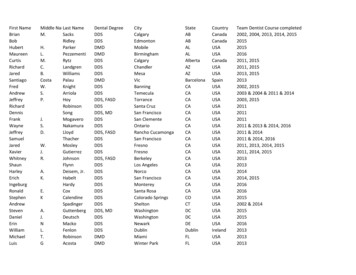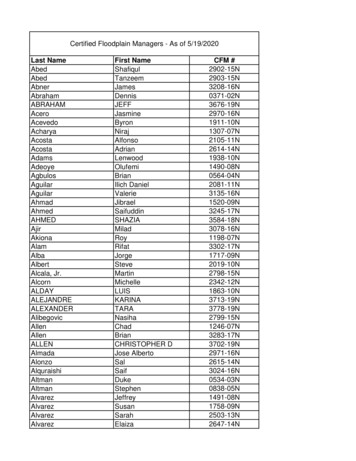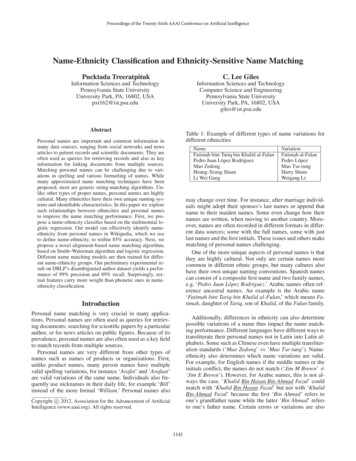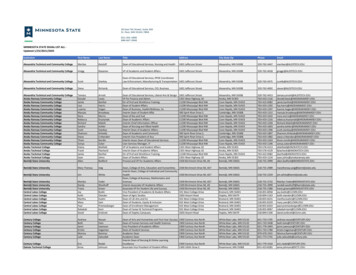![[NAME OF STATE] - SAMHSA](/img/8/state-certification-guide.jpg)
Transcription
State Certification Guide[NAME OF STATE]Certified Community Behavioral HealthClinic Certification GuideJuly 2015
Certified Community Behavioral Health Clinics State Certification GuideOVERVIEW: CCBHC STATE CERTIFICATION GUIDEBackgroundThe Protecting Access to Medicare Act (PAMA) § 223 laid the groundwork for the establishment of Certified CommunityBehavioral Health Clinics (CCBHCs). In accordance with that legislation, in 2015 the Substance Abuse and MentalHealth Services Administration (SAMHSA) published Criteria for the Demonstration Program to Improve CommunityMental Health Centers and to Establish Certified Community Behavioral Health Clinics (the Criteria) as part of theRequest for Applications (RFA) for Planning Grants. The Planning Grants will be awarded to as many as 25 states toplan for and develop proposals to establish CCBHCs as part of a 2-year demonstration program— and up to 8 states willbe selected for the demonstration. In addition to the Criteria, the RFA included Centers for Medicare & MedicaidServices (CMS) guidance for the development of a Prospective Payment System (PPS)-- each state awarded a PlanningGrant must develop a PPS during the planning period in order to be considered for the demonstration program. Statesselected to participate in the demonstration also will be part of an evaluation mandated by PAMA, to be conducted by theDepartment of Health & Human Services Assistant Secretary for Planning and Evaluation (ASPE). Jurisdictions eligibleto participate in these opportunities include the 50 U.S. states and the District of Columbia (hereinafter referred to as“states”).Purpose of CCBHC State Certification GuideThis CCBHC State Certification Guide is designed to be a tool for states to use as they undertake certification ofCCBHCs in their jurisdiction. It is not a substitute for the Criteria or the PPS guidance; rather, it provides technicalassistance that states may use as they wish. It includes a series of questions, arranged by Criteria programrequirements, so that states systematically address key issues as they assess the qualifications of prospective CCBHCs.It also includes an appendix listing reference documents and websites with useful information. The series of questionsthat relate to the CCBHC criteria and program requirements were developed with the recognition that states may wish tocustomize this document to reflect decisions they make regarding what is necessary for certification in their jurisdiction.Because many parts of the Criteria are flexible and were drafted to meet the needs of individual states, this guide also isdesigned to be flexible and to be useful to states as they navigate the certification process.2Rev. July 2015
Certified Community Behavioral Health Clinics State Certification GuideTABLE OF 3.C3.DSECTION I: STAFFINGGENERAL STAFFING REQUIREMENTSLICENSURE AND CREDENTIALING OF PROVIDERSCULTURAL COMPETENCE AND OTHER TRAININGLINGUISTIC COMPETENCECriteriaSECTION 2: AVAILABILITY AND ACCESSIBILITY OF SERVICESCriteriaGENERAL REQUIREMENTS OF ACCESS AND AVAILABILITYREQUIREMENTS FOR TIMELY ACCESS TO SERVICES AND INITIAL AND COMPREHENSIVE EVALUATION FORNEW CONSUMERSACCESS TO CRISIS MANAGEMENT SERVICESNO REFUSAL OF SERVICES DUE TO INABILITY TO PAYPROVISION OF SERVICES REGARDLESS OF RESIDENCESECTION 3: CARE COORDINATIONCriteriaGENERAL REQUIREMENTS OF CARE COORDINATIONCARE COORDINATION AND OTHER HEALTH INFORMATION SYSTEMSCARE COORDINATION AGREEMENTSTREATMENT TEAM, TREATMENT PLANNING AND CARE COORDINATION ACTIVITIESPage57911Page1315192123Page252932373Rev. July 2015
Certified Community Behavioral Health Clinics State Certification No.6.A6.B6.CNo.ASECTION 4: SCOPE OF SERVICESCriteriaGENERAL SERVICE PROVISIONSREQUIREMENT OF PERSON-CENTERED AND FAMILY-CENTERED CARECRISIS BEHAVIORAL HEALTH SERVICESSCREENING, ASSESSMENT, AND DIAGNOSISPERSON-CENTERED AND FAMILY-CENTERED TREATMENT PLANNINGOUTPATIENT MENTAL HEALTH AND SUBSTANCE USE SERVICESOUTPATIENT CLINIC PRIMARY CARE SCREENING AND MONITORINGTARGETED CASE MANAGEMENT SERVICESPSYCHIATRIC REHABILITATION SERVICESPEER SUPPORTS, PEER COUNSELING, AND FAMILY/CAREGIVER SUPPORTSINTENSIVE, COMMUNITY-BASED MENTAL HEALTH CARE FOR MEMBERS OF THE ARMED FORCES ANDVETERANSSECTION 5: QUALITY AND OTHER REPORTINGDATA COLLECTION, REPORTING, AND TRACKINGCONTINUOUS QUALITY IMPROVEMENT (CQI) PLANCriteriaSECTION 6: ORGANIZATIONAL AUTHORITY, GOVERNANCE, AND ACCREDITATIONCriteriaGENERAL REQUIREMENTS OF ORGANIZATIONAL AUTHORITY AND ting Reference Documents And Page697174Page754Rev. July 2015
Certified Community Behavioral Health Clinics State Certification GuideSECTION I: STAFFINGCriteria 1.A: GENERAL STAFFING REQUIREMENTSAuthority: Section 223 (a(2(A))) of PAMADocuments to Review Onsite or in Advance: (1) clinic policies and procedures; (2) service area map; (3) key management staff position descriptions andbiographical sketches or resumes; (4) organizational chart; (5) if relevant, documentation of attempts to obtain a psychiatrist as Medical Director anddocumentation of status as a Health Resources and Services Administration (HRSA) behavioral health professional shortage area; and (6) clinic liability andmalpractice insurance documentationRequirements1.a.1. As part of the process leading to certification, the state willprepare an assessment of the needs of the target consumer populationand a staffing plan for prospective CCBHCs. The needs assessment willinclude cultural, linguistic and treatment needs. The needs assessment isperformed prior to certification of the CCBHCs in order to inform staffingand services. After certification, the CCBHC will update the needsassessment and the staffing plan, including both consumer andfamily/caregiver input. The needs assessment and staffing plan will beupdated regularly, but no less frequently than every three years.QuestionsA. Is there a copy of the state-prepared needsassessment available to review on site? How arethe identified needs being addressed by the clinic?Does the clinic adequately meet the cultural,linguistic and treatment needs of the populationbeing served?1.a.2 The staff (both clinical and non-clinical) is appropriate for servingthe consumer population in terms of size and composition and providingthe types of services the CCBHC is required to and proposes to offer.A. On the basis of the needs assessment, is the staff(those responsible for carrying out both clinical andnonclinical services) appropriate for: (1) serving thepatient population in terms of size and compositionand (2) providing the types of services that theclinic is required to and proposes to offer?Note: See criteria 4.K relating to required staffing of services forveterans.ResponseB. Does the clinic have a defined service area that isconsidered in their planning and service delivery?C. Skip for initial review: -Is there evidence that theclinic reassesses needs and staffing at least every3 years?5Rev. July 2015
Certified Community Behavioral Health Clinics State Certification GuideRequirements1.a.3 The Chief Executive Officer (CEO) of the CCBHC maintains afully staffed management team as appropriate for the size and needs ofthe clinic as determined by the current needs assessment and staffingplan. The management team will include, at a minimum, a CEO orExecutive Director/Project Director, and a psychiatrist as MedicalDirector. The Medical Director need not be a full-time employee of theCCBHC. Depending on the size of the CCBHC, both positions(CEO/Executive Director/Project Director and the Medical Director) maybe held by the same person. The Medical Director will ensure the medicalcomponent of care and the integration of behavioral health (includingaddictions) and primary care are facilitated.Note: If a CCBHC is unable, after reasonable and consistent efforts, toemploy or contract with a psychiatrist as Medical Director because of adocumented behavioral health professional shortage in its vicinity (asdetermined by the Health Resources and Services Administration(HRSA), psychiatric consultation will be obtained on the medicalcomponent of care and the integration of behavioral health and primarycare, and a medically trained behavioral health care provider withappropriate education and licensure with prescriptive authority inpsychopharmacology who can prescribe and manage medicationsindependently pursuant to state law will serve as the Medical Director.1.a.4 The CCBHC maintains liability/malpractice insurance adequatefor the staffing and scope of services provided.QuestionsA. Does the clinic have a management team structurewith key personnel identified by name, including aCEO or Executive Director/Project Director and aMedical Director? Note that depending on the sizeof the clinic, both positions (CEO/ExecutiveDirector/Project Director and Medical Director) maybe held by the same person.ResponseB. Is a psychiatrist designated as Medical Director? Ifnot, is there documentation regarding (1) theclinic’s location is a HRSA-designated behavioralhealth professional shortage area, (2) thatreasonable efforts to obtain a psychiatrist asMedical Director were made, (3) arrangements forpsychiatric consultation have been made to reviewthe medical components of care, and (4) the nameand credentials of an alternate prescribing medicalcare (non-psychiatrist) provider who serves as theclinic Medical Director.A. Does the clinic have documentation ofliability/malpractice insurance adequate for thestaffing and scope of services provided (, e.g.,policy and coverage schedule)?6Rev. July 2015
Certified Community Behavioral Health Clinics State Certification GuideCriteria 1.B: LICENSURE AND CREDENTIALING OF PROVIDERSAuthority: Section 223 (a(2(A))) of PAMADocuments to Review Onsite or in Advance: (1) Staffing plan; (2) staffing profile; (3) provider contracts, agreements, and any other relevant documentation ofcollaborative relationships; (4) credentialing policies and procedures; (5) documentation of provider licensure or certification for all licensed or certified clinicpractitioners; and (6) documentation of supervisionRequirementsQuestionsA. Are all clinic and DCO providers appropriately1.b.1 All CCBHC providers who furnish services directly, and anylicensed or certified to perform the activities andDesignated Collaborating Organization (DCO) providers that furnishprocedures detailed within the clinic’s approvedservices under arrangement with the CCBHC, are legally authorized inscope of services,accordance with federal, state and local laws, and act only within thescope of their respective state licenses, certifications, or registrations andB. Does the clinic have a method for tracking allin accordance with all applicable laws and regulations, including anyproviders and ensuring that they maintain theirapplicable state Medicaid billing regulations or policies. Pursuant to thelicensure, certification, or credentialing, asrequirements of the statute (PAMA § 223 (a)(2)(A)), CCBHC providersappropriate?have and maintain all necessary state-required licenses, certifications, orother credentialing documentation, with providers working towardC. Is there documentation that any unlicensedlicensure, and appropriate supervision in accordance with applicable stateproviders who are working toward licensure arelaw.receiving the supervision required as part of thatprocess?ResponseNote: CCBHCs are not precluded by anything in this criterion fromutilizing providers working towards licensure, provided they are workingunder the requisite supervision.1.b.2 The CCBHC staffing plan meets the requirements of the statebehavioral health authority and any accreditation standards required bythe state, is informed by the state’s initial needs assessment, andincludes clinical and peer staff. In accordance with the staffing plan, theCCBHC maintains a core staff comprised of employed and, as needed,contracted staff, as appropriate to the needs of CCBHC consumers asstated in consumers’ individual treatment plans and as required byprogram requirements 3 and 4 of these criteria. States specify which staffdisciplines they will require as part of certification but must include aA. Does the clinic’s staffing plan meet therequirements of the state behavioral healthauthority and any accreditation or other standardsrequired by the state?B. Does the clinic include a medically trainedbehavioral health care provider who can prescribeand manage medications independently understate law, including buprenorphine and othermedications used to treat opioid and alcohol use7Rev. July 2015
Certified Community Behavioral Health Clinics State Certification GuideRequirementsmedically trained behavioral health care provider, either employed oravailable through formal arrangement, who can prescribe and managemedications independently under state law, including buprenorphine andother medications used to treat opioid and alcohol use disorders. TheCCBHC must have staff, either employed or available through formalarrangements, who are credentialed substance abuse specialists.Providers must include individuals with expertise in addressing traumaand promoting the recovery of children and adolescents with seriousemotional disturbance (SED) and adults with serious mental illness (SMI)and those with substance use disorders. Examples of staff the state mightrequire include a combination of the following: (1) psychiatrists (includingchild, adolescent, and geriatric psychiatrists), (2) nurses trained to workwith consumers across the lifespan, (3) licensed independent clinicalsocial workers, (4) licensed mental health counselors, (5) licensedpsychologists, (6) licensed marriage and family therapists, (7) licensedoccupational therapists, (8) staff trained to provide case management, (9)peer specialist(s)/recovery coaches, (10) licensed addiction counselors,(11) staff trained to provide family support, (12) medical assistants, and(13) community health workers. The CCBHC supplements its core staff,as necessary given program requirements 3 and 4 and individualtreatment plans, through arrangements with and referrals to otherproviders.Note: Recognizing professional shortages exist for many behavioralhealth providers: (1) some services may be provided by contract or parttime or as needed; (2) in CCBHC organizations comprised of multipleclinics, providers may be shared among clinics; and (3) CCBHCs mayutilize telehealth/telemedicine and on-line services to alleviate shortages.Questionsdisorders as well as other medical or psychiatricdisorders?ResponseC. Are peer staff members included in the staffingplan?D. Does the clinic either employ or make availablethrough formal arrangements providers who arecredentialed substance abuse specialists?E. Does the clinic have staff with expertise inaddressing trauma and promoting the recovery ofchildren and adolescents with SED, adults withSMI, and those with primary or co-occurringsubstance use disorders?F. Is the clinic located in a behavioral healthprofessional shortage area (as determined byHRSA) and, if so, is that documented? (Please see1.a.3.B above)G. Does the clinic take appropriate steps (e.g.,scheduling providers at multiple clinics, use oftelehealth services or online services, use ofsupervised providers-in-training) to alleviateprofessional shortages where they exist?8Rev. July 2015
Certified Community Behavioral Health Clinics State Certification GuideCriteria 1.C: CULTURAL COMPETENCE AND OTHER TRAININGAuthority: Section 223 (a(2(A))) of PAMADocuments to Review Onsite or in Advance: (1) Training plan; (2) staff and other provider training records; (3) policies and procedures governing training; and (4)provider contracts, agreements, and any other relevant documentation of collaborative relationships related to other providers or to interpretation/translationservices (as applicable)Requirements1.c.1 The CCBHC has a training plan for all employed and contractstaff, and for providers at DCOs who have contact with CCBHCconsumers or their families, which satisfies and includes requirements ofthe state behavioral health authority and any accreditation standards ontraining which may be required by the state. Training must addresscultural competence; person- centered and family-centered, recoveryoriented, evidence-based and trauma-informed care; and primarycare/behavioral health integration. This training, as well as training on theclinic’s continuity of operations plan, occurs at orientation and thereafterat reasonable intervals as may be required by the state or accreditingagencies.At orientation and annually thereafter, the CCBHC provides trainingabout: (1) risk assessment, suicide prevention and suicide response; (2)the roles of families and peers; and (3) such other trainings as may berequired by the state or accrediting agency on an annual basis. Ifnecessary, trainings may be provided on-line.QuestionsA. Does the clinic have a training plan in compliancewith state standards for all staff employed andcontracted to provide services to consumers andtheir families? This includes providers at DCOswho serve clinic consumers.BResponseAt orientation and at reasonable intervalsthereafter, do all clinic personnel, including thoseproviders who are contracted with or work at aDCO, receive training that addresses culturalcompetency; person-centered, family-centered,recovery-oriented, evidence-based, and traumainformed care; primary care/behavioral healthintegration; and the clinic’s continuity plan?C. At orientation and annually thereafter, does theclinic provide (at a minimum) training on (1) riskassessment, suicide prevention, and suicideresponse; (2) the roles of families and peers; and(3) other trainings required by the state oraccrediting agency?9Rev. July 2015
Certified Community Behavioral Health Clinics State Certification GuideRequirementsCultural competency training addresses diversity within the organization’sservice population and, to the extent active duty military or veterans arebeing served, must include information related to military culture.Examples of cultural competency training and materials include, but arenot limited to, those available through the website of the US Departmentof Health & Human Services (DHHS), the SAMHSA website through thewebsite of the DHHS, Office of Minority Health, or through the website ofthe DHHS, Health Resources and Services Administration.Note: See criteria 4.K relating to cultural competency requirements inservices for veterans.1.c.2 The CCBHC assess the skills and competence of eachindividual furnishing services and, as necessary, provides in-servicetraining and education programs. The CCBHC has written policies andprocedures describing its method(s) of assessing competency andmaintains a written accounting of the in-service training provided duringthe previous 12 months.QuestionsD. Are cultural competency trainings and materialsprovided to staff to address diversity within thepopulation being served? Are these sufficient andeffective?ResponseE. If veterans are served, does cultural competencytraining satisfy the requirements of criteria 4.K?A. Does the clinic have written policies andprocedures that describe the methods forassessing the skills and competencies ofproviders? Are these policies and proceduresroutinely followed, and records kept of theseassessments?B. Are in-service training and education programsprovided for individuals furnishing services (asnecessary)?C. Does clinic maintain a list of in-service trainingand educational programs provided during theprevious 12 months?1.c.3 The CCBHC documents in the staff personnel records that thetraining and demonstration of competency are successfully completed.A. Within personnel records, does the clinic maintaindocumentation that staff have completedtraining(
This CCBHC State Certification Guide is designed to be a tool for states to use as they undertake certification of CCBHCs in their jurisdiction. It is not a substitute for the Criteria or the PPS guidance; rather, it provides technical assistance that states may use as they wish. It includes a series of questions, arranged by Criteria program
